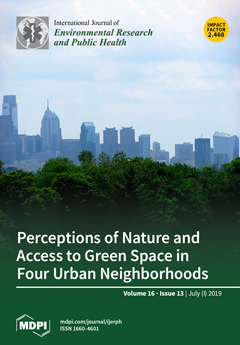This study aimed to assess the pollution and potential ecological risk of seven heavy metals (Cd, Cr, Cu, Hg, Ni, Pb, and Zn) in the sewage sludge collected from a wastewater treatment plant (WWTP), located in the most industrialized region of Poland (Silesian
[...] Read more.
This study aimed to assess the pollution and potential ecological risk of seven heavy metals (Cd, Cr, Cu, Hg, Ni, Pb, and Zn) in the sewage sludge collected from a wastewater treatment plant (WWTP), located in the most industrialized region of Poland (Silesian Voivodeship). The concentrations of heavy metals were determined using inductively coupled plasma optical spectrometry (ICP-OES) and cold vapor atomic absorption spectrometry (CVAAS). The chemical forms (chemical speciation) of heavy metals were determined using the three-step chemical sequential extraction procedure, developed by the Community Bureau of Reference (BCR). To assess the pollution level and potential ecological risk, the following indices were used: Geoaccumulation Index (I
geo), Potential Ecological Risk Factor (ER), Individual Contamination Factor (ICF), modified Risk Assessment Code (RAC
m), and Ecological Risk Factor (ERF)—the author’s index. Sludge samples were collected at successive stages of processing. The results revealed that the activated sludge process and sludge thickening have a significant impact on heavy metal distribution, while anaerobic digestion and dehydration decrease their mobility. The most dominant metals in the sludge samples were Zn and Cu. However, the content of heavy metals in sewage sludge did not exceed the permissible standards for agricultural purposes. The concentrations of heavy metals bound to the immobile fractions exhibited higher concentrations, compared to those bound to mobile fractions (except Zn). The values of the total indices indicated that sludge samples were moderately to highly contaminated with Zn, Hg, Cd, Cu, and Pb, of which only Hg, Cd, and Cu posed a potential ecological risk, while according to the speciation indices, sludge samples were moderately to very highly polluted with Zn, Cu, Cd, Cr, and Ni, of which Zn, Ni, and Cd were environmentally hazardous. The obtained results proved that assessment of the pollution level and potential ecological risk of heavy metals in sewage sludge requires knowledge on both their total concentrations and their chemical forms. Such an approach will help prevent secondary pollution of soils with heavy metals, which may influence the reduction of health risks associated with the consumption of plants characterized by a high metal content.
Full article





